Optimization and Benchmarking of RT-LAMP-CRISPR-Cas12a for the Detection of SARS-CoV-2 in Saliva
Abstract
1. Introduction
2. Results and Discussion
2.1. RT-LAMP Reaction Optimization
2.2. Cas12a Reaction Optimisation
2.3. Comparison of RT-RPA and RT-LAMP When Coupled to Cas12a Detection
2.4. Comparison of Liquid and Lyophilised Preparations of RT-LAMP When Coupled to Cas12a Detection
2.5. RT-LAMP Target Amplification and Cas12a Detection in One-Tube
2.6. Comparison of Optimized RT-LAMP-Cas (Lba) Protocol with Standard RT-qPCR Assay for Detection of SARS-CoV-2 in Saliva Samples
3. Materials and Methods
3.1. Oligonucleotides and Control RNA
3.2. SARS-CoV-2 Assay Material
3.3. Sample Lysis
3.4. Ribonucleoprotein Complexes
3.5. RT-LAMP
3.6. RT-RPA
3.7. RT-qPCR
3.8. Cas12a Trans-Cleavage Assay and Visualisation
3.9. One-Tube Assay
3.10. Data Analysis
4. Conclusions
Supplementary Materials
Author Contributions
Funding
Institutional Review Board Statement
Informed Consent Statement
Data Availability Statement
Acknowledgments
Conflicts of Interest
Abbreviations
| MDPI | Multidisciplinary Digital Publishing Institute |
| POU | Point-of-use |
| RCA | Rolling circle amplification |
| RT-LAMP | Reverse-transcription loop-mediated isothermal amplification |
| RT-RPA | Reverse-transcription recombinase polymerase amplification |
| crRNA | CRISPR RNA |
| DETECTR | DNA Endonuclease-Targeted CRISPR Trans Reporter |
| Lyo | Lyophilized |
| RNP | Ribonucleoprotein |
| AUC | Area under the curve |
References
- Inaba, M.; Higashimoto, Y.; Toyama, Y.; Horiguchi, T.; Hibino, M.; Iwata, M.; Imaizumi, K.; Doi, Y. Diagnostic accuracy of LAMP versus PCR over the course of SARS-CoV-2 infection. Int. J. Infect. Dis. 2021, 107, 195–200. [Google Scholar] [CrossRef] [PubMed]
- Jhou, Y.-R.; Wang, C.-H.; Tsai, H.-P.; Shan, Y.-S.; Lee, G.-B. An integrated microfluidic platform featuring real-time reverse transcription loop-mediated isothermal amplification for detection of COVID-19. Sens. Actuators B Chem. 2022, 358, 131447. [Google Scholar] [CrossRef]
- Lai, M.Y.; Suppiah, J.; Thayan, R.; Ismail, I.; Mustapa, N.I.; Soh, T.S.T.; Hassan, A.H.; Peariasamy, K.M.; Lee, Y.L.; Lau, Y.L. RNA purification-free detection of SARS-CoV-2 using reverse transcription loop-mediated isothermal amplification (RT-LAMP). Trop. Med. Health 2022, 50, 2. [Google Scholar] [CrossRef] [PubMed]
- Promlek, T.; Thanunchai, M.; Phumisantiphong, U.; Hansirisathit, T.; Phuttanu, C.; Dongphooyao, S.; Thongsopa, W.; Nuchnoi, P. Performance of colorimetric reverse transcription loop-mediated isothermal amplification as a diagnostic tool for SARS-CoV-2 infection during the fourth wave of COVID-19 in Thailand. Int. J. Infect. Dis. 2022, 116, 133–137. [Google Scholar] [CrossRef] [PubMed]
- Kumari, R.; Lim, J.W.; Sullivan, M.R.; Malampy, R.; Baush, C.; Smolina, I.; Robin, H.; Demidov, V.V.; Ugolini, G.S.; Auclair, J.R.; et al. A novel rolling circle amplification-based detection of SARS-CoV-2 with multi-region padlock hybridization. Diagnostics 2022, 12, 2252. [Google Scholar] [CrossRef]
- Broughton, J.P.; Deng, W.; Fasching, C.L.; Singh, J.; Chiu, C.Y.; Chen, J.S. A Protocol for Rapid Detection of the 2019 Novel Coronavirus SARS-CoV-2 Using CRISPR Diagnostics: SARS-CoV-2 DETECTR; Mammoth Biosciences Inc.: Brisbane, CA, USA, 2020. [Google Scholar]
- Hu, F.; Liu, Y.; Zhao, S.; Zhang, Z.; Li, X.; Peng, N.; Jiang, Z. A one-pot CRISPR/Cas13a-based contamination-free biosensor for low-cost and rapid nucleic acid diagnostics. Biosens. Bioelectron. 2022, 202, 113994. [Google Scholar] [CrossRef]
- Joung, J.; Ladha, A.; Saito, M.; Kim, N.G.; Woolley, A.E.; Segel, M.; Barretto, R.P.; Ranu, A.; Macrae, R.K.; Faure, G.; et al. Detection of SARS-CoV-2 with SHERLOCK One-Pot Testing. N. Engl. J. Med. 2020, 383, 1492–1494. [Google Scholar] [CrossRef] [PubMed]
- Kellner, M.J.; Koob, J.G.; Gootenberg, J.S.; Abudayyeh, O.O.; Zhang, F. SHERLOCK: Nucleic acid detection with CRISPR nucleases. Nat. Protoc. 2019, 14, 2986–3012. [Google Scholar] [CrossRef] [PubMed]
- Wang, R.; Qian, C.; Pang, Y.; Li, M.; Yang, Y.; Ma, H.; Zhao, M.; Qian, F.; Yu, H.; Liu, Z.; et al. opvCRISPR: One-pot visual RT-LAMP-CRISPR platform for SARS-CoV-2 detection. Biosens. Bioelectron. 2021, 172, 956–5663. [Google Scholar] [CrossRef]
- Pu, R.; Liu, S.; Ren, X.; Shi, D.; Ba, Y.; Huo, Y.; Zhang, W.; Ma, L.; Liu, Y.; Yang, Y.; et al. The screening value of RT-LAMP and RT-PCR in the diagnosis of COVID-19: Systematic review and meta-analysis. J. Virol. Methods 2022, 300, 114392. [Google Scholar] [CrossRef]
- Mannier, C.; Yoon, J.-Y. Progression of LAMP as a result of the COVID-19 Pandemic: Is PCR finally rivaled? Biosensors 2022, 12, 492. [Google Scholar] [CrossRef]
- Wang, B.; Wang, R.; Wang, D.; Wu, J.; Li, J.; Wang, J.; Liu, H.; Wang, Y. Cas12aVDet: A CRISPR/Cas12a-based platform for rapid and visual nucleic acid detection. Anal. Chem. 2019, 91, 12156–12161. [Google Scholar] [CrossRef]
- Qiu, X.; Liu, X.; Ma, X.; Wang, R.; Chen, S.; Li, F.; Li, Z. One-Pot Isothermal LAMP-CRISPR-Based assay for Klebsiella pneumoniae detection. Microbiol. Spectr. 2022, 10, e01545-22. [Google Scholar] [CrossRef] [PubMed]
- Nguyen, L.T.; Gurijala, J.; Rananaware, S.R.; Pizzano, B.L.; Stone, B.T.; Jain, P.K. CRISPR-ENHANCE: An enhanced nucleic acid detection platform using Cas12a. Methods 2022, 203, 116–124. [Google Scholar] [CrossRef]
- Wu, H.; Chen, Y.; Yang, Q.; Peng, C.; Wang, X.; Zhang, M.; Qian, S.; Xu, J.; Wu, J. A reversible valve-assisted chip coupling with integrated sample treatment and CRISPR/Cas12a for visual de-tection of Vibrio parahaemolyticus. Biosens. Bioelectron. 2021, 188, 113352. [Google Scholar] [CrossRef] [PubMed]
- Chen, Y.; Mei, Y.; Zhao, X.; Jiang, X. Reagents-Loaded, automated assay that integrates recombinase-aided amplification and Cas12a nucleic acid detection for a point-of-care test. Anal. Chem. 2020, 92, 14846–14852. [Google Scholar] [CrossRef]
- Fuchs, R.T.; Curcuru, J.L.; Mabuchi, M.; Noireterre, A.; Weigele, P.R.; Sun, Z.; Robb, G.B. Characterization of Cme and Yme thermostable Cas12a orthologs. Commun. Biol. 2022, 5, 325. [Google Scholar] [CrossRef] [PubMed]
- Wu, J.; Gao, P.; Shi, Y.-J.; Zhang, C.; Tong, X.; Fan, H.; Zhou, X.; Zhang, Y.; Yin, H. Characterization of a thermostable Cas12a ortholog. Cell Insight 2023, 2, 100126. [Google Scholar] [CrossRef] [PubMed]
- Mahas, A.; Marsic, T.; Lopez-Portillo Masson, M.; Wang, Q.; Aman, R.; Zheng, C.; Ali, Z.; Alsanea, M.; Al-Qahtani, A.; Ghanem, B.; et al. Characterization of a thermostable Cas13 enzyme for one-pot detection of SARS-CoV-2. Proc. Natl. Acad. Sci. USA 2022, 119, e2118260119. [Google Scholar] [CrossRef] [PubMed]
- Pena, J.M.; Manning, B.J.; Li, X.; Fiore, E.S.; Carlson, L.; Shytle, K.; Nguyen, P.P.; Azmi, I.; Larsen, A.; Wilson, M.K.; et al. Real-Time, multiplexed SHERLOCK for in vitro diagnostics. J. Mol. Diagn. 2023, 25, 428–437. [Google Scholar] [CrossRef]
- Nguyen, L.T.; Smith, B.M.; Jain, P.K. Enhancement of trans-cleavage activity of Cas12a with engineered crRNA enables amplified nucleic acid detection. Nat. Commun. 2020, 11, 4906. [Google Scholar] [CrossRef]
- Moon, S.B.; Lee, J.M.; Kang, J.G.; Lee, N.-E.; Ha, D.-I.; Kim, D.Y.; Kim, S.H.; Yoo, K.; Kim, D.; Ko, J.-H.; et al. Highly efficient genome editing by CRISPR-Cpf1 using CRISPR RNA with a uridinylate-rich 3′-overhang. Nat. Commun. 2018, 9, 3651. [Google Scholar] [CrossRef] [PubMed]
- Nalefski, E.A.; Kooistra, R.M.; Parikh, I.; Hedley, S.; Rajaraman, K.; Madan, D. Determinants of CRISPR Cas12a nuclease activation by DNA and RNA targets. Nucleic Acids Res. 2024, 52, 4502–4522. [Google Scholar] [CrossRef]
- Drummond, R. Cas12 Detection Methods and Compositions. WO 2022/118200 A1, 9 June 2023. [Google Scholar]
- Smith, C.W.; Kachwala, M.J.; Nandu, N.; Yigit, M.V. Recognition of DNA Target Formulations by CRISPR-Cas12a Using a dsDNA Reporter. ACS Synth. Biol. 2021, 10, 1785–1791. [Google Scholar] [CrossRef]
- Rossetti, M.; Merlo, R.; Bagheri, N.; Moscone, D.; Valenti, A.; Saha, A.; Arantes, P.R.; Ippodrino, R.; Ricci, F.; Treglia, I.; et al. Enhancement of CRISPR/Cas12a trans-cleavage activity using hairpin DNA reporters. Nucleic Acids Res. 2022, 50, 8377–8391. [Google Scholar] [CrossRef] [PubMed]
- Sun, Y.; Yu, L.; Liu, C.; Ye, S.; Chen, W.; Li, D.; Huang, W. One-tube SARS-CoV-2 detection platform based on RT-RPA and CRISPR/Cas12a. J. Transl. Med. 2021, 19, 74. [Google Scholar] [CrossRef]
- Subsoontorn, P.; Lohitnavy, M.; Kongkaew, C. The diagnostic accuracy of isothermal nucleic acid point-of-care tests for human coronaviruses: A systematic review and meta-analysis. Sci. Rep. 2020, 10, 22349. [Google Scholar] [CrossRef] [PubMed]
- Diagne, C.T.; Faye, M.; Lopez-Jimena, B.; Abd El Wahed, A.; Loucoubar, C.; Fall, C.; Mencatelli, G.; Faye, O.; Faye, O.; Weidmann, M.; et al. Comparative analysis of Zika Virus detection by RT-qPCR, RT-LAMP, and RT-RPA. In Methods in Mo-lecular Biology; Humana Press Inc.: Totowa, NJ, USA, 2020; Volume 2142, pp. 165–179. [Google Scholar]
- Naveen, K.P.; Bhat, A.I. Development of reverse transcription loop-mediated isothermal amplification (RT-LAMP) and reverse transcription recombinase polymerase amplification (RT-RPA) assays for the detection of two novel viruses infecting ginger. J. Virol. Methods 2020, 282, 113884. [Google Scholar] [CrossRef]
- Panpradist, N.; Wang, Q.; Ruth, P.S.; Kotnik, J.H.; Oreskovic, A.K.; Miller, A.; Stewart, S.W.; Vrana, J.; Han, P.D.; Beck, I.A.; et al. Simpler and faster COVID-19 testing: Strategies to streamline SARS-CoV-2 molecular assays. EBioMedicine 2021, 64, 103236. [Google Scholar] [CrossRef] [PubMed]
- Xu, Y.; Xu, T.; Chen, S.; Yao, H.; Chen, Y.; Zeng, Y.; Chen, F.; Zhang, G. Evaluation of a novel lyophilized-pellet-based 2019-nCoV nucleic acid detection kit for the diagnosis of COVID-19. PLoS ONE 2023, 18, e0292902. [Google Scholar] [CrossRef] [PubMed]
- Auer, A.; Panzarin, V.; Monne, I.; Crimaudo, M.; Angot, A.; Gourlaouen, M.; Lamien, C.E.; Cattoli, G. Comparative assessment of lyophilized and wet reagents for the molecular detection of H5N1 high pathogenic avian influenza virus and H9N2 low pathogenic avian influenza virus. J. Virol. Methods 2023, 314, 114686. [Google Scholar] [CrossRef] [PubMed]
- Xu, J.; Wang, J.; Zhong, Z.; Su, X.; Yang, K.; Chen, Z.; Zhang, D.; Li, T.; Wang, Y.; Zhang, S.; et al. Room-temperature-storable PCR mixes for SARS-CoV-2 detection. Clin. Biochem. 2020, 84, 73–78. [Google Scholar] [CrossRef] [PubMed]
- Das, A.; Spackman, E.; Senne, D.; Pedersen, J.; Suarez, D.L. Development of an internal positive control for rapid diagnosis of avian influenza virus infections by real-time reverse transcription-PCR with lyophilized reagents. J. Clin. Microbiol. 2006, 44, 3065–3073. [Google Scholar] [CrossRef] [PubMed]
- Malzahn, A.A.; Tang, X.; Lee, K.; Ren, Q.; Sretenovic, S.; Zhang, Y.; Chen, H.; Kang, M.; Bao, Y.; Zheng, X.; et al. Application of CRISPR-Cas12a temperature sensitivity for improved genome editing in rice, maize, and Arabidopsis. BMC Biol. 2019, 17, 9. [Google Scholar] [CrossRef] [PubMed]
- Okiro, L.A.; Tancos, M.A.; Nyanjom, S.G.; Smart, C.D.; Parker, M.L. Comparative evaluation of LAMP, qPCR, conventional PCR, and ELISA to detect Ralstonia solanacearum in Kenyan potato fields. Plant Dis. 2018, 103, 959–965. [Google Scholar] [CrossRef] [PubMed]
- Huang, X.; Tang, G.; Ismail, N.; Wang, X. Developing RT-LAMP assays for rapid diagnosis of SARS-CoV-2 in saliva. EBioMedicine 2022, 75, 103736. [Google Scholar] [CrossRef]
- Bottino, P.; Massarino, C.; Leli, C.; Scomparin, E.; Bara, C.; Gotta, F.; Cornaglia, E.; Felici, E.; Gentile, M.; Ranzan, S.; et al. Evaluation of a commercial rapid molecular point-of-care assay for differential diagnosis between SARS-CoV-2 and Flu A/B infections in a pediatric setting. Viruses 2024, 16, 1638. [Google Scholar] [CrossRef] [PubMed]
- Bikos, D.A.; Hwang, C.; Brileya, K.A.; Parker, A.; Loveday, E.K.; Rodriguez, M.; Thornton, I.; LeFevre, T.; Wilking, J.N.; Dills, M.; et al. SARS-CoV-2 Detection in the nasopharyngeal swabs and saliva of college students using RT-qPCR and RT-LAMP. medRxiv 2024. [Google Scholar] [CrossRef]
- Choi, G.; Moehling, T.J.; Meagher, R.J. Advances in RT-LAMP for COVID-19 testing and diagnosis. Expert Rev. Mol. Diagn. 2023, 23, 9–28. [Google Scholar] [CrossRef]
- Robin, X.; Turck, N.; Hainard, A.; Tiberti, N.; Lisacek, F.; Sanchez, J.-C.; Müller, M. pROC: An open-source package for R and S+ to analyze and compare ROC curves. BMC Bioinform. 2011, 12, 77. [Google Scholar] [CrossRef]
- Sachs, M.C. plotROC: A Tool for Plotting ROC Curves. J. Stat. Softw. 2017, 79, 1–19. [Google Scholar] [CrossRef] [PubMed]
- López-Ratón, M.; Rodríguez-Álvarez, M.X.; Suárez, C.C.; Sampedro, F.G. OptimalCutpoints: An R package for selecting optimal cutpoints in diagnostic tests. J. Stat. Softw. 2014, 61, 1–36. [Google Scholar] [CrossRef]
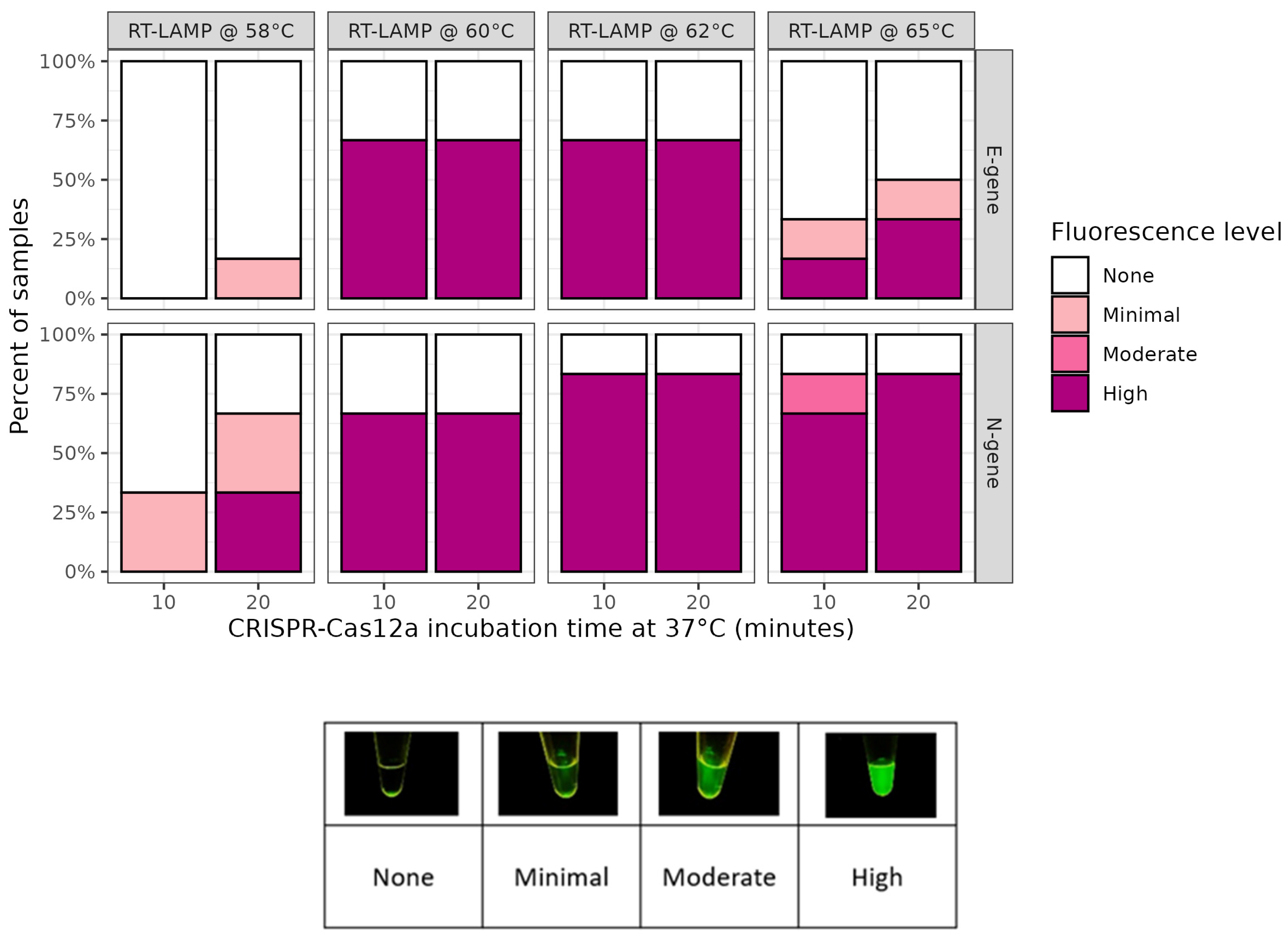
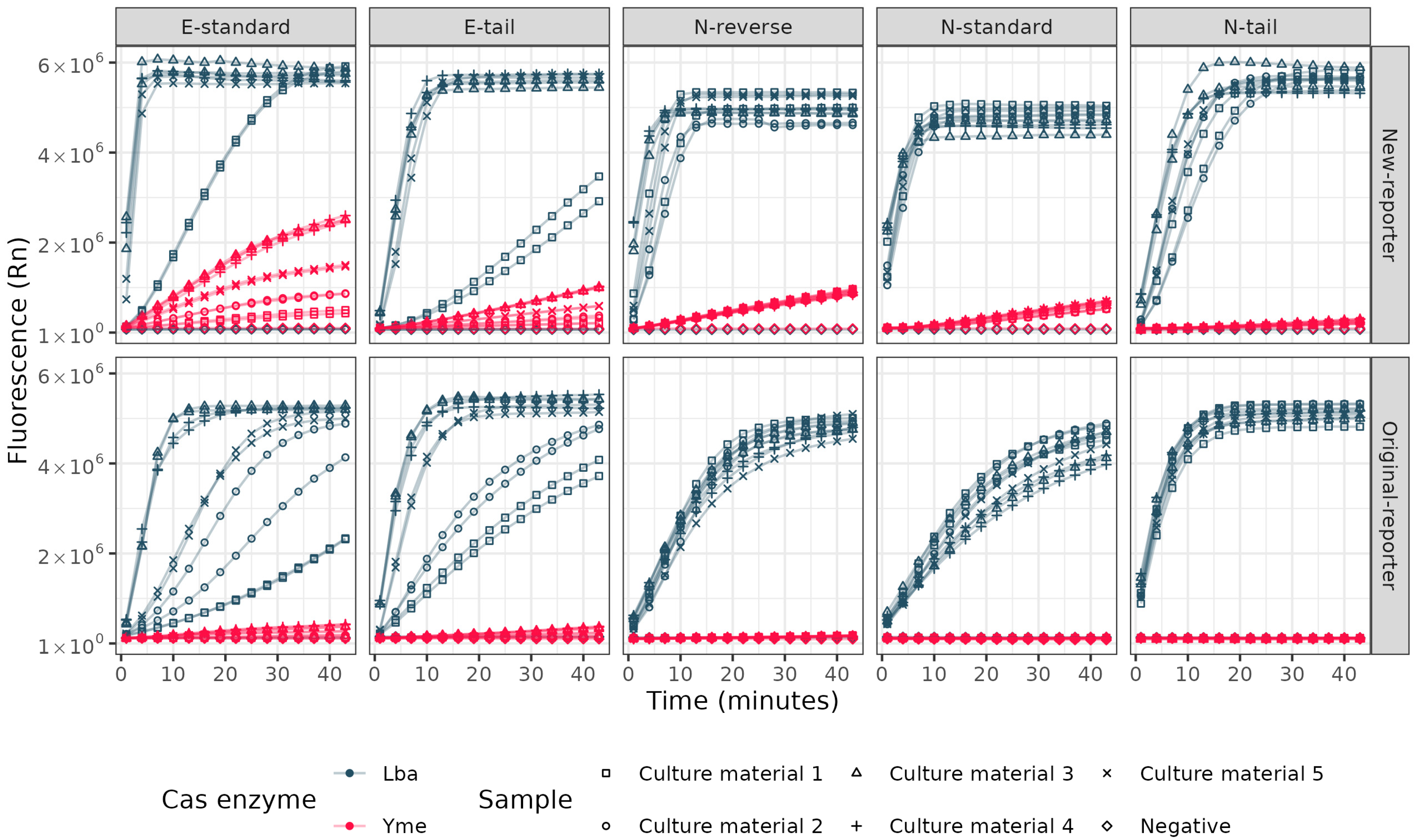
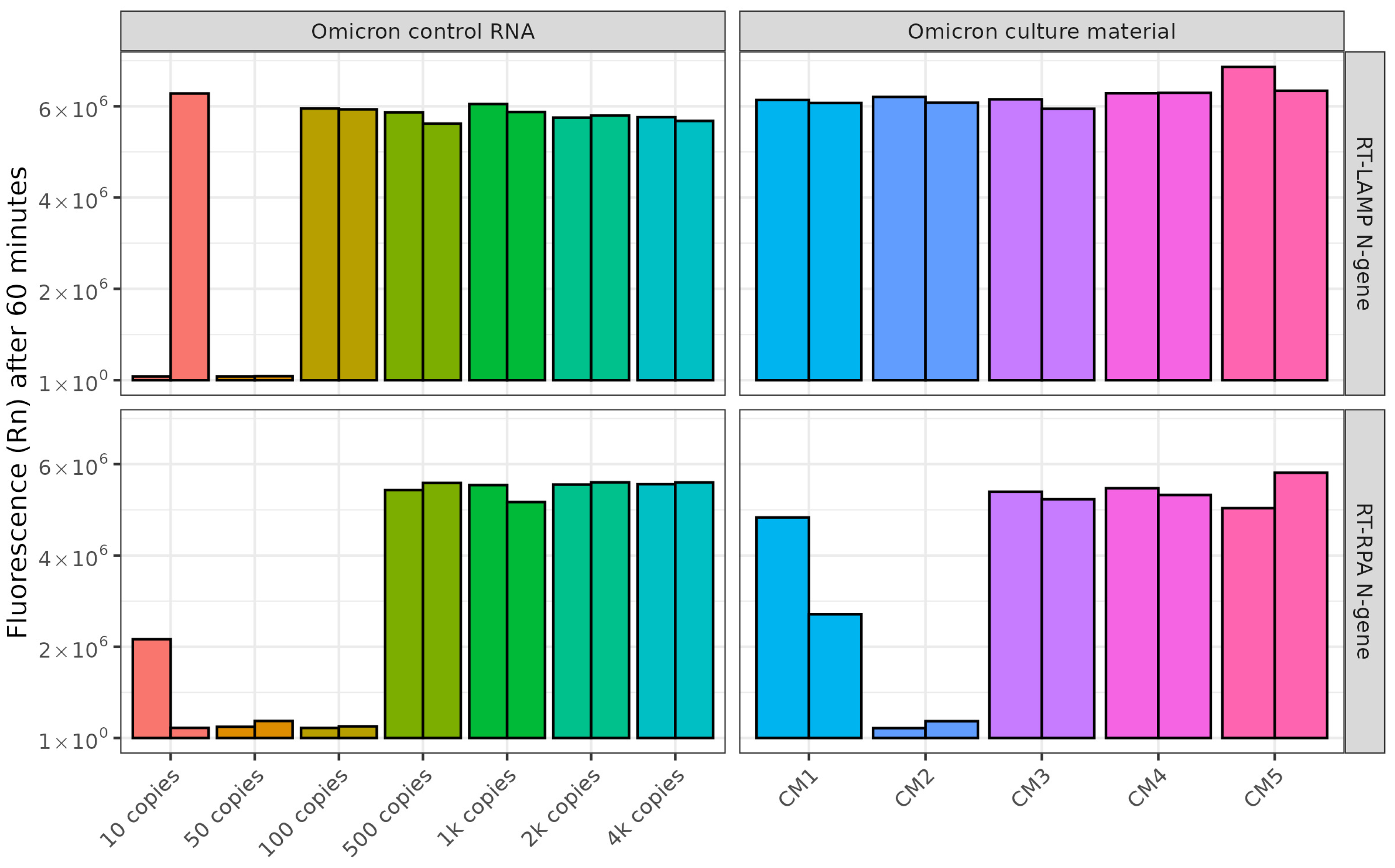

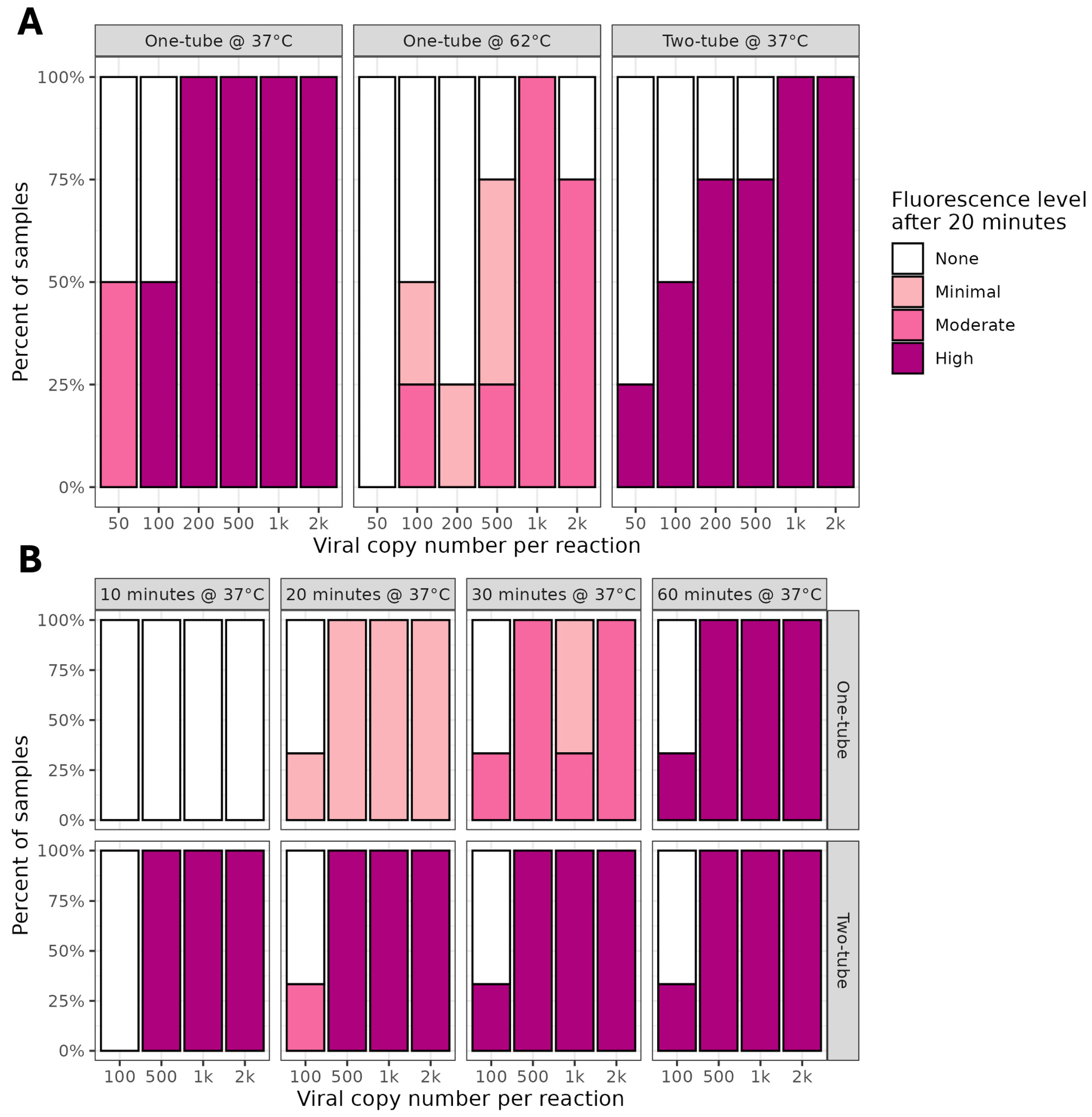
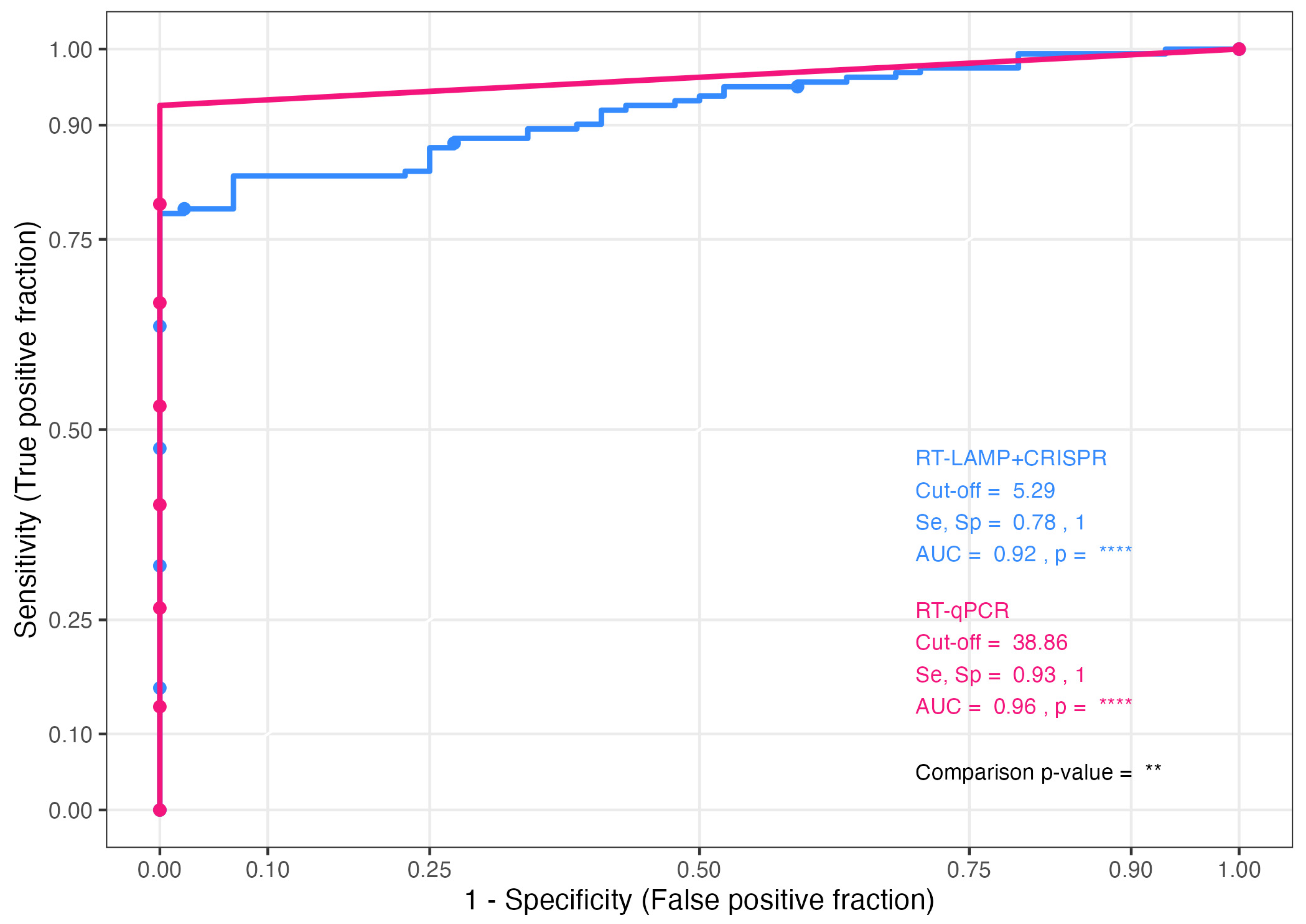
Disclaimer/Publisher’s Note: The statements, opinions and data contained in all publications are solely those of the individual author(s) and contributor(s) and not of MDPI and/or the editor(s). MDPI and/or the editor(s) disclaim responsibility for any injury to people or property resulting from any ideas, methods, instructions or products referred to in the content. |
© 2025 by the authors. Licensee MDPI, Basel, Switzerland. This article is an open access article distributed under the terms and conditions of the Creative Commons Attribution (CC BY) license (https://creativecommons.org/licenses/by/4.0/).
Share and Cite
Lynch, C.R.H.; Drummond, R.S.M.; Jelley, L.; Baker, L.; Smit, E.; Fleming, R.; Billington, C. Optimization and Benchmarking of RT-LAMP-CRISPR-Cas12a for the Detection of SARS-CoV-2 in Saliva. Int. J. Mol. Sci. 2025, 26, 1806. https://doi.org/10.3390/ijms26051806
Lynch CRH, Drummond RSM, Jelley L, Baker L, Smit E, Fleming R, Billington C. Optimization and Benchmarking of RT-LAMP-CRISPR-Cas12a for the Detection of SARS-CoV-2 in Saliva. International Journal of Molecular Sciences. 2025; 26(5):1806. https://doi.org/10.3390/ijms26051806
Chicago/Turabian StyleLynch, Courtney R. H., Revel S. M. Drummond, Lauren Jelley, Lauren Baker, Erasmus Smit, Rachel Fleming, and Craig Billington. 2025. "Optimization and Benchmarking of RT-LAMP-CRISPR-Cas12a for the Detection of SARS-CoV-2 in Saliva" International Journal of Molecular Sciences 26, no. 5: 1806. https://doi.org/10.3390/ijms26051806
APA StyleLynch, C. R. H., Drummond, R. S. M., Jelley, L., Baker, L., Smit, E., Fleming, R., & Billington, C. (2025). Optimization and Benchmarking of RT-LAMP-CRISPR-Cas12a for the Detection of SARS-CoV-2 in Saliva. International Journal of Molecular Sciences, 26(5), 1806. https://doi.org/10.3390/ijms26051806





